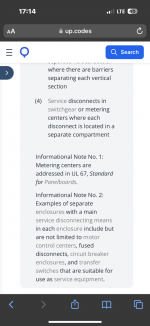Seven-Delta-FortyOne
Goin’ Down In Flames........
- Location
- Humboldt
- Occupation
- EC and GC
I hope I make sense.
I was remembering a provision where if there are several actual enclosures that make up the “service disconnect”, the N-G bond does not necessarily have to be in the actual box that contains the main disconnect switch.
Basically, you could have a meter in an enclosure, a main in an enclosure, a distribution panel, all connected with metal conduit, and it’s considered one……I don’t know what.
My specific reason for asking is if such a thing is allowed, then why couldn’t a transfer switch be mounted adjacent to a main panel, 2 metal nipples connecting them, and not have to separate neutrals and grounds?
I was remembering a provision where if there are several actual enclosures that make up the “service disconnect”, the N-G bond does not necessarily have to be in the actual box that contains the main disconnect switch.
Basically, you could have a meter in an enclosure, a main in an enclosure, a distribution panel, all connected with metal conduit, and it’s considered one……I don’t know what.
My specific reason for asking is if such a thing is allowed, then why couldn’t a transfer switch be mounted adjacent to a main panel, 2 metal nipples connecting them, and not have to separate neutrals and grounds?


